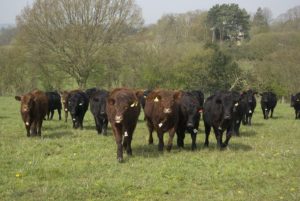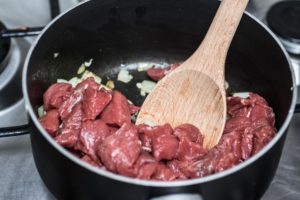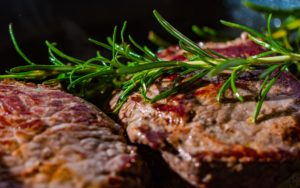Summer BBQs are approaching, camping season is pretty much here, and beef is on the menu! May is officially beef month. This healthy, high protein food is good for you and good for the land – while cattle graze they turn low quality forage and other grasses into high quality protein we can eat. Cattle are ruminant animals, basically meaning they can eat the tough-to-break-down cellulose in grasses that we can’t. Even dairy cattle graze pasture lands and become nutritious beef. And yummy food isn’t the last of it, the farmers and ranchers who care for these animals also care about the land, their stewardship, and providing you good food – we know, because we work with them!
Where’s the beef?
There are approximately 600,000 beef cows on about 11,000 ranches in California. In addition, there are 1.78 million dairy cows, which also play an important role in the state’s beef industry. Cattle are ruminants, which means they have a four-chambered stomach, remember, they can eat stuff we humans cannot – turning sun, into grass, into beef, into human fuel!
 Beef cattle are raised in every county in California except San Francisco. Tulare is the leading county in California cattle production at 20.9%, followed by Fresno at 12.3%, Imperial at 10%, then Merced and Kern both at 7.9%.
Beef cattle are raised in every county in California except San Francisco. Tulare is the leading county in California cattle production at 20.9%, followed by Fresno at 12.3%, Imperial at 10%, then Merced and Kern both at 7.9%.
The beef you eat
You have options when it comes to your beef. While grass-finished beef tends to be a little leaner, both grass-finished and grain-finished beef are natural sources of more than 10 essential nutrients including protein, iron, and zinc. All cattle, whether grass or grain-finished, spend the majority of their lives eating grass on pastures and provide delicious and nutritious beef.
A little nutrition info: (Based on a 3 oz. serving)
- Nearly half of the recommended daily value for protein
- Less than 10 grams of fat
- 4.5 grams or less of saturated fat
- Less than 95 mg of cholesterol
Besides tasting great, the nutrients in lean beef, such as protein, iron, and B- vitamins, can help satisfy you and maintain a healthy weight, build muscles and fuel a healthy and active lifestyle. Oh, how could we forget?! Research suggests that eating lean beef can also improve cholesterol levels! Kind of a big deal.
vitamins, can help satisfy you and maintain a healthy weight, build muscles and fuel a healthy and active lifestyle. Oh, how could we forget?! Research suggests that eating lean beef can also improve cholesterol levels! Kind of a big deal.
Get even more good info at: www.beefitswhatsfordinner.com
So you wanna cook it right?
Don’t forget to marinate! Tender beef cuts can be marinated for 15 minutes to 2 hours for flavor; less tender cuts, such as Flank Steak, should be marinated for 6 hours, but not more than 24 hours.
When Stir-Frying, cook beef and vegetables separately, then combine and heat through.
Skillet cooking: When selecting your skillet, look for a thick bottomed pan with a  strong coating for the best and most even cooking. One of the best sizes to use is a 12″ pan. This allows for the beef to be browned without crowding the pan.
strong coating for the best and most even cooking. One of the best sizes to use is a 12″ pan. This allows for the beef to be browned without crowding the pan.
Pan-frying is best for thin, tender beef cuts, 1/2 inch thick or less. Cubed steak, or other cuts that are floured or breaded, may require additional oil to prevent sticking.
Stewing beef: Cook until fork-tender. To test for doneness, insert a double-pronged meat fork into the thickest part of the beef. When the fork can be inserted with little resistance and releases easily when pulled out, your beef is done.
Oven roasting: To carve a Rib Roast, turn the roast on its side and place on carving board. Insert fork from the side, below the top rib. Carve across the “face” of the roast toward the rib bone. Cut along the rib bone with the tip of the knife to release a slice of beef.
Are you ready? Try-out this quick and easy beef & asparagus pasta recipe here – *we made it and it’s family, especially kid, approved!


